
- •Foreword
- •Preface
- •Key to Diagrams
- •Reading Pressure and Options
- •Reacting to Support the Breakout
- •Breakout Plays
- •Control Breakouts
- •Counters
- •Regroups
- •Dump-In Entries
- •Mid-Ice Entries
- •Wide-Lane Drives
- •The Funnel
- •Two-on-One Attacks
- •Two-on-Two Attacks
- •Three-on-Two Attacks
- •Offsides
- •Activating Defense Into Offensive Zone Entries
- •Cycling
- •Playing Behind the Net
- •Stretching the Zone: Low-High Plays
- •Activating Defense in the Offensive Zone
- •Attack Zone Plays
- •Power-Play Breakouts
- •Gaining and Maintaining Possession off the Entry
- •Zone Setup
- •Five-on-Three Power Play
- •Four-on-Three Power Play
- •Forechecking Systems
- •Neutral Zone Forechecking
- •Neutral Zone Forechecking Systems
- •Neutral Zone Backchecking
- •Neutral Zone Backchecking Systems
- •Handling Defensive Zone Entries
- •Defensive Zone Systems
- •Situational Guidelines for Defensive Zone Coverag
- •Face-Offs and Penalty Kills
- •Forechecking and Penalty Kills
- •Pressuring the Entry
- •Defensive Zone Play
- •Three-on-Five Penalty Kill
- •Three-on-Four Penalty Kill
- •Offensive Zone Face-Offs
- •Neutral Zone Face-Offs
- •Defensive Zone Face-Offs
- •Power-Play Face-Offs
- •Penalty-Kill Face-Offs
- •Special Face-Off Situations
- •Managing Staff
- •Dealing With Officials
- •Adjusting Your Playing Strategy
- •Managing Lines
- •Line Changes
- •Handling the Moment
- •Index
- •About the Authors
Stretching the Zone: Low-High Plays
With many teams playing a collapsing defensive style (one where all five defenders play low in the offensive zone), it is often difficult in the attacking zone to penetrate the net area without using low-high plays. Low-high plays spread out the defense and create opportunities to get the puck to scoring areas with more time and space. This strategy must be identified before a game as part of the game plan.
Offensive players with the puck make a quick pass to the point (F1 to D1) when they get the puck low or possibly recover a loose rebound in the corner (figure 4.5). D1 can now make a decision to shoot, move the puck to D2, or pass back to one of the forwards. Having the puck move from down low to the blue line creates a gap in the defensive alignment because the defensive wingers try to rush to their point coverage, leaving space between them and their defense. When all five defensive players are down low, the scoring area is crowded; getting the defensive wingers to move out high creates more space in the slot. Each time defenders scramble to defend the high blue line area, there is opportunity for offensive players to find more time and space to create better offensive chances low. Also, the shot from the point, through traffic, is still a primary option to create scoring chances.
Figure 4.5 Stretching the zone.
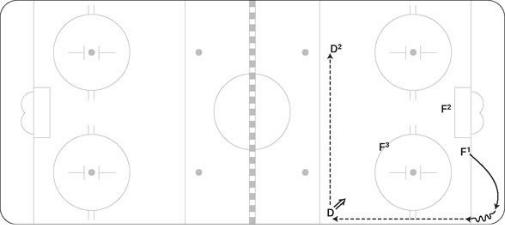
Activating Defense in the Offensive Zone
Much like other aspects of offensive play, coaches have to decide how comfortable they are with getting their Ds involved in the offense. Basically, how much risk do they want to take? If the offensive team has quality puck possession, there is little risk in allowing the defense to move in offensively. You have to teach your players to make good decisions with the puck and trust that they will make a safe play rather than a dangerous play. The key rules for defensemen that will help minimize risk are as follows:
1.Only one D at a time goes deep into the offensive zone.
2.Read the time of the game and the score—Ds should be more cautious when moving in offensively late in periods or when your team has the lead.
3.The forwards must have quality puck possession in order for the defense to activate.
4.When the defense move in, if a pass is not made do not “hang out”—get back to the blue line quickly.
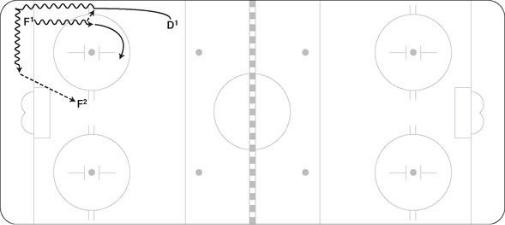
Attack Zone Plays
This section describes special plays made in the offensive zone using an active defense. The plays are all effective and provide a variety of options.
■ STRONG-SIDE SLIDE
D1 reads that F1 is cycling out of the corner, so he slides down the boards and receives an exchange pass from F1. The exchange is like a handoff in football, where the puck carrier protects the puck and gives it to D1. D1 now has the option of driving the net with the puck or cutting behind the net with possession and looking for a passing option (figure 4.6). F1 should cycle out high and remain in a defensive position until D1 recovers.
Figure 4.6
■ MIDSEAM PENETRATION
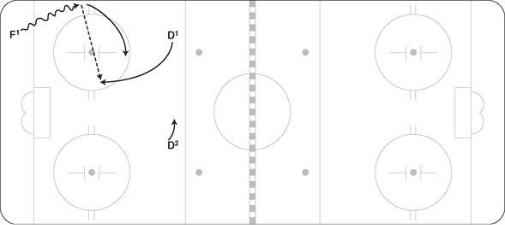
When D1 sees the defensive team overplaying the boards, he should slide into mid-ice and down through the slot toward the net. F1 should use deception by looking as if he will pass to the point and then making a quick pass to D1, who is moving through the middle of the slot. D1 may have an opportunity to shoot quickly or move in deeper (figure 4.7). Once again F1 should move out to a higher defensive position after the pass in case of a turnover.
Figure 4.7
■ BACK-SIDE SLIDE
When the offensive player (F1) has the puck and D2 reads that the defensive team is overplaying one side of the ice, D2 should quickly move down the back side and be ready for the pass. F1 tries to find an open seam to thread the pass through to the wide side. If D2 doesn’t get the pass when moving in, he should get out immediately. Once again, this play should be made quickly and with deception so that attention is not drawn to the defenseman moving in. This is a riskier play because of the distance of the pass and the number of players in the area but if D2 gets the pass
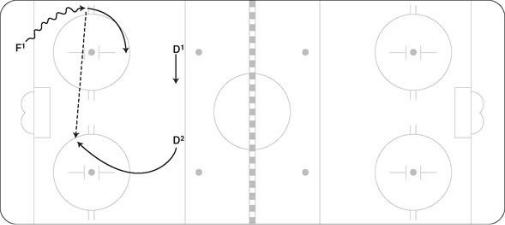
clean he will have a great scoring chance (figure 4.8).
Figure 4.8
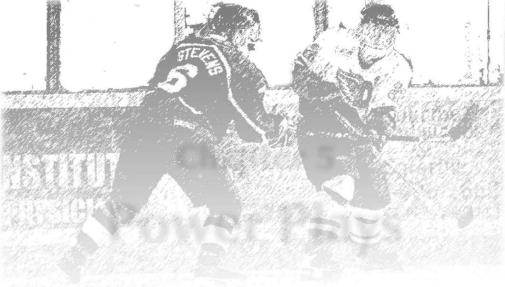
Chapter 5
Power Plays
When developing the power play, the coach must go through several *steps including selecting a formation, describing the skills necessary for each position, slotting players into positions, developing drills to practice the skills, and finally allowing players to offer input as they mature and possibly the opportunity to select their own options within the framework. Most coaches go through these steps before the season starts once they know the makeup of the team. It is important as a coach to follow these steps, and then review them from time to time as your lineup changes or when you are looking for improvements.
1. Select a formation. We will discuss three formations in this chapter. Identify which formation is suited for the abilities of the players available to you. Certain players are more suited to execute one better than another. The differentiating factor is usually the skill level and how good they are at passing, seeing the ice, and shooting off the pass.
2.Describe skills necessary for each position. Make a list of all the skills needed to play each position in the formation selected. Keep this as a checklist when working on the power play in practice. Also use it to decide which players in your lineup are best suited to play each position. For example, the following six skills are critical for defensemen on the power play: deception, walking the blue line on the forehand and backhand, shooting, onetiming the puck, seeing the opening and making a pass through the box, and skating into the open seam at the right time. Under the section on zone set up you will find the skills listed for each player. This should help you build a checklist and decide which players are best suited for a particular position.
3.Slot players into the positions. Decide based on the skills required where each player should play in the system. On the power play there will be some interchange, but generally each player will become proficient in one of the five positions. One of the harder positions to play is the front of the net. You would like someone with size who also has very good hands to corral a rebound or quickly release a shot off the pass. This player cannot be afraid of being hit with the puck and needs to have a touch for deflecting and redirecting pucks.
4 . Develop or select drills to practice skills. Develop a bank of drills to work on the skills of the chosen power-
play alignment and also the breakout options. Sometimes the power-play breakout drills can be included with regular breakout practice. When developing in-zone skills, it is definitely better to start with no resistance and then progress to working against penalty killers. Players of all ages need to focus for the first month or so on constant repetitions with no resistance and get their puck movement and timing down before progressing to resistance. If penalty killers are introduced too early in practice situations, it will only lead to frustration.
5 . Allow players freedom to choose the right options.
Much like a quarterback in football, one or two players on the power play should take the lead and pick the best available play or shot. As you will see in the specific alignments, there are five or six set plays to choose from. It is better to have set options than to allow the power play to freelance. Once the players become familiar with the alignments and have practiced them enough, the options will become instinctive. Let the power play group watch video on a regular basis so they become familiar with the options that arise with different penalty-kill alignments and pressure.
6. Repeat for specific situations. All of the previous steps must now be repeated for five-on-three and four-on-three situations.
When developing and monitoring the power play, coaches should remember that small details create the power. These are the little things that make a successful power play.
 Outwork the penalty-killing unit. Recognizing that they have the advantage, most power plays let up a bit with regard to effort, but this shouldn’t happen.
Outwork the penalty-killing unit. Recognizing that they have the advantage, most power plays let up a bit with regard to effort, but this shouldn’t happen.
 Give your team momentum by getting scoring chances and shots. At all levels the best power plays units only score on 2 out of every 10 power plays, but you should create momentum for your team on every power play.
Give your team momentum by getting scoring chances and shots. At all levels the best power plays units only score on 2 out of every 10 power plays, but you should create momentum for your team on every power play.
 Look confident—never show dejection or defeat. Body language is so important in sports. Don’t give your opponent any signs that you don’t think you can score. Leave the ice with the attitude that you didn’t score this time, but it will definitely happen next time.
Look confident—never show dejection or defeat. Body language is so important in sports. Don’t give your opponent any signs that you don’t think you can score. Leave the ice with the attitude that you didn’t score this time, but it will definitely happen next time.
 Have two units with two looks. Confuse the other team’s penalty-killing units by having a different setup for each of your units.
Have two units with two looks. Confuse the other team’s penalty-killing units by having a different setup for each of your units.
 Win the draw! Face-offs are so key on special teams. It takes 15 to 20 seconds to get set up again in the zone if the other team clears the puck.
Win the draw! Face-offs are so key on special teams. It takes 15 to 20 seconds to get set up again in the zone if the other team clears the puck.
 Try to give other players on your team an opportunity to go on the power play—this will do wonders for their confidence. Make sure in practice that all players work on power-play skills.
Try to give other players on your team an opportunity to go on the power play—this will do wonders for their confidence. Make sure in practice that all players work on power-play skills.
